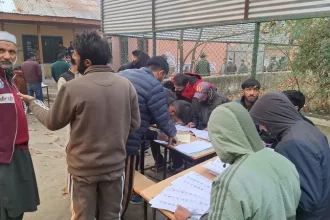SRINAGAR: In a major urban development push, the Jammu and Kashmir administration is planning to establish 30 satellite townships along the proposed Semi-Ring Road around Srinagar. According to media reports, this ambitious plan involves transforming large tracts of agricultural land into residential and commercial hubs, sparking widespread concerns among locals and political leaders alike.
The project, as reported by Daily Excelsior, envisions developing 30 townships between Galander in Pampore and Ganderbal. Each township would span approximately 200 hectares, requiring a total of 6,000 hectares (nearly 118,000 kanals), much of which is prime agricultural land. Landowners would be expected to pool their properties under the recently approved JK Land Pooling Policy ’24, partnering with private developers for urban settlements.
Concerns of Land Scarcity and Livelihood Displacement
Kashmir, a land-scarce region, faces the dual challenge of losing vital agricultural land and displacing livelihoods tied to farming. Farmers in affected areas have expressed dissent, raising fears about being left landless and without alternative sources of income. Several villages in Budgam, Pulwama, and other districts are already under scrutiny by revenue officials as plans for township development advance.
A delegation of farmers recently met with the Divisional Commissioner of Kashmir to voice their opposition. Local leaders, including People’s Democratic Party (PDP) chief spokesperson Dr. Mehboob Beg, have criticized the lack of clarity about the township’s beneficiaries. “The government must explain whether these townships are meant for Jammu and Kashmir domiciles and why construction in the restricted zones is barred,” Dr. Beg said.
Urban Growth Versus Regional Policies
The government has justified the initiative as a step toward controlled urban growth, citing the Srinagar Master Plan. The administration claims that landowners will benefit from serviced plots with higher value under the land pooling model. However, critics argue that the plan violates land-use policies and undermines the region’s agricultural sustainability.
Political leaders have also questioned why land acquisition compensation bypassed the national Right to Fair Compensation and Transparency in Land Acquisition Act (2013) in favor of the obsolete Jammu and Kashmir Land Acquisition Act (1934), despite the latter being repealed after the abrogation of Article 370.
Semi-Ring Road: Development and Challenges
The Semi-Ring Road, a ₹2,919 crore project implemented by the National Highways Authority of India (NHAI), aims to connect Srinagar with six districts through a 42.1 km stretch. Divided into two phases, the road’s construction has already impacted 4730 kanals of agricultural land across multiple districts. The project’s infrastructure includes 290 culverts, two flyovers, and a toll plaza, with completion anticipated soon.
As the road nears completion, the township proposal has emerged as a contentious issue, pitting urban development ambitions against the preservation of Kashmir’s agricultural heritage and livelihoods. How the administration addresses these challenges will shape the future of Srinagar’s urban landscape and its people.








